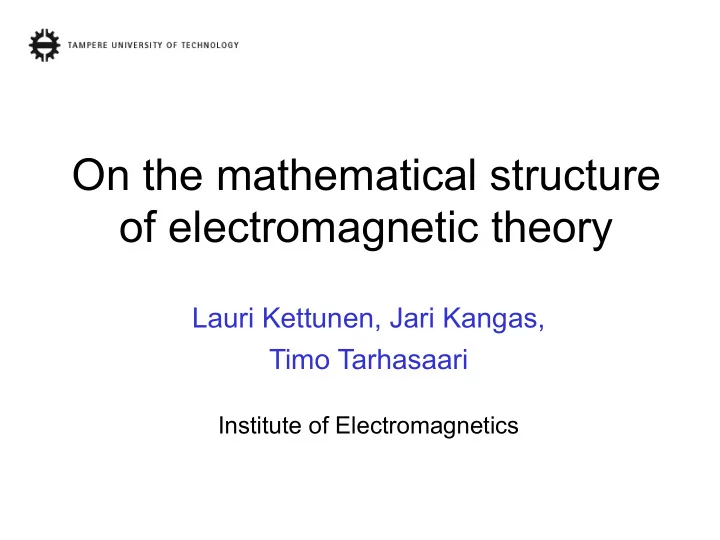

On the mathematical structure of electromagnetic theory Lauri Kettunen, Jari Kangas, Timo Tarhasaari Institute of Electromagnetics
One theory, different ”languages”: Classical vector analysis Differential forms
… or in terms of chains and cochains Now, let’s ask: Are these various forms of the theory ”equal”?
Different languages do represent the very same theory, but they start from different assumptions. Vector analysis has its pedagogical advantages in representing electromagnetism, … but it starts from the metric structure (The metric structure is what makes the approach pedagogical; For, lengths, areas, volumes, norms, etc are all in use. )
Modern approach • …based on differential forms, (co)chains, etc. is more abstract, for less structure is assumed at the first place.
In computing … • … the advantage is: less structure results in more simple code Basic idea: Employ only the structure which is necessary. As a result the underlying code is more generic and less complicated to develop and maintain.
Recognition of the structure ... • enables one to formalize and properly solve certain questions (S. Suuriniemi’s talk) • enables one to circumvent some technical problems which are considered difficult (P. Raumonen’s talk) Recognition of the employed structure yields a better understanding of the underlying physics behind electromagnetism
The expected advantages has created a trend of geometrization in electromagnetism
List of needs in computation: 1. A discrete counterpart to a smooth manifold M 2. A discrete counterpart to differential forms, i.e. cochains 3. A discrete counterpart to integration, i.e. evaluation of cochains on chains 4. A discrete coboundary d with discrete version of Stokes theorem <du,c> = <u, bd c> 5. A discrete version of the global inner product of forms [ , ]
6. A discrete Hodge operator 7. A discrete wedge product and volume form 8. A discrete adjoint coboundary map 9. All of this should converge to the continuum theory in an appropriate limit 10. These are all compatible with the expected relations holding such as [u,v] = int_M u/\*v= int_M (u,v) vol, Ref: Discussion with J. Harrison, Univ. Berkeley and A. Bossavit, Univ. Paris
Chainlet theory ... • basically includes all this, but it is not yet known, how chainlets should be capitalized in finite element kind of computing Chainlet theory, ref: J. Harrison
Recommend
More recommend